Related Research Articles

The Apple II series is a family of home computers, one of the first highly successful mass-produced microcomputer products, designed primarily by Steve Wozniak, manufactured by Apple Computer, and launched in 1977 with the original Apple II.

The Amstrad CPC is a series of 8-bit home computers produced by Amstrad between 1984 and 1990. It was designed to compete in the mid-1980s home computer market dominated by the Commodore 64 and the Sinclair ZX Spectrum, where it successfully established itself primarily in the United Kingdom, France, Spain, and the German-speaking parts of Europe.
Software cracking is the modification of software to remove or disable features which are considered undesirable by the person cracking the software, especially copy protection features or software annoyances like nag screens and adware.
Copy protection, also known as content protection, copy prevention and copy restriction, describes measures to enforce copyright by preventing the reproduction of software, films, music, and other media.
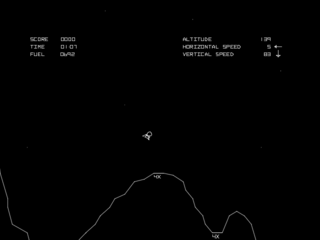
Lunar Lander is a genre of video games loosely based on the 1969 landing of the Apollo Lunar Module on the Moon. In Lunar Lander games, players generally control a spacecraft as it falls toward the surface of the Moon or other astronomical body, using thrusters to slow the ship's descent and control its horizontal motion to reach a safe landing area. Crashing into obstacles, hitting the surface at too high a velocity, or running out of fuel all result in failure. In some games in the genre, the ship's orientation must be adjusted as well as its horizontal and vertical velocities.
Timeworks Publisher was a desktop publishing (DTP) program produced by GST Software in the United Kingdom.
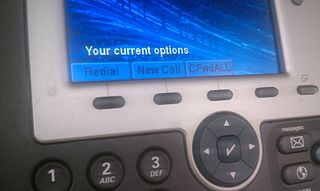
A soft key is a button flexibly programmable to invoke any of a number of functions rather than being associated with a single fixed function or a fixed set of functions. A softkey often takes the form of a screen-labeled function key located alongside a display device, where the button invokes a function described by the text at that moment shown adjacent to the button on the display. Soft keys are also found away from the display device, for example on the sides of cellular phones, where they are typically programmed to invoke functions such as PTT, memo, or volume control. Function keys on keyboards are a form of soft key. In contrast, a hard key is a key with dedicated function such as the keys on a number keypad.
Rob Northen Copylock is a copy-protection system designed to prevent disk duplication with standard floppy disk drives on the Amiga, Atari ST and MS-DOS platforms. It was created by British programmer Rob Northen after founding his own company Copylock Software. It was used mainly to prevent games from being copied by regular users.
Amiga software is computer software engineered to run on the Amiga personal computer. Amiga software covers many applications, including productivity, digital art, games, commercial, freeware and hobbyist products. The market was active in the late 1980s and early 1990s but then dwindled. Most Amiga products were originally created directly for the Amiga computer, and were not ported from other platforms.

Microdeal was a British software company which operated during the 1980s and early 1990s from its base at Truro Road in the town of St Austell, Cornwall. The company, founded by John Symes was one of the major producers of games and other software for the 8-bit home computers of the time, in particular the Dragon 32 and the similar Tandy TRS-80 Color Computer ("CoCo").

Computist was a magazine devoted to the Apple II personal computer that was published by Charles R. Haight under the SoftKey Publishing name, between 1981 and 1993, for a total of 89 issues. The magazine was based in Tacoma, Washington. Originally launched as Hardcore Computing, the 'hardcore' part was formally dropped from the title with the 27th issue.

The Apple II Plus is the second model of the Apple II series of personal computers produced by Apple Computer. It was sold from June 1979 to December 1982. Approximately 380,000 II Pluses were sold during its four years in production before being replaced by the IIe in 1983.
Anatolius of Laodicea, also known as Anatolios of Alexandria, became Bishop of Laodicea on the Mediterranean coast of Roman Syria in AD 268. He was not only one of the foremost scholars of his day in the physical sciences as well as in Aristotelean philosophy but also a great computist.
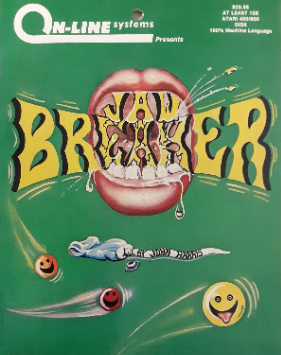
Jawbreaker is a Pac-Man clone programmed by John Harris for the Atari 8-bit family and published by On-Line Systems. Released in 1981 before an official version of Pac-Man was available, it was widely lauded by reviewers, and became a major seller. The story of its creation and Harris's Atari 8-bit implementation of Frogger form a portion of Steven Levy's 1984 book, Hackers: Heroes of the Computer Revolution.
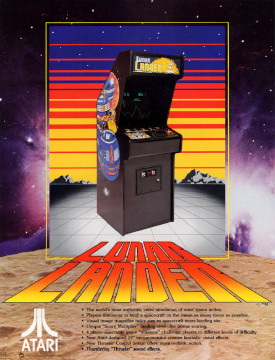
Lunar Lander is a single-player arcade game in the Lunar Lander subgenre. It was developed by Atari, Inc. and released in August 1979. It was the most popular version to date of the "Lunar Lander" concept, surpassing the prior Moonlander and numerous text-based games, and most later versions of the concept are based on this Atari version.
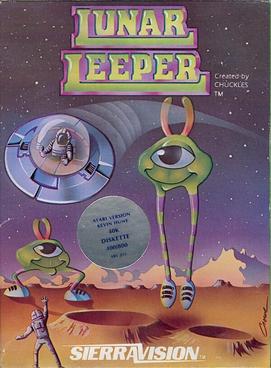
Lunar Leeper, also released as Lunar Leepers, is a horizontally scrolling shooter written by Chuck Bueche and published under Sierra On-Line's SierraVision label in 1982. It was released for the Apple II, Atari 8-bit family, Commodore 64, and VIC-20. The Apple II version of the game was copy-protected using Sierra's Spiradisc system.

Where in Europe Is Carmen Sandiego? is a 1988 European geography-based educational computer game in the Carmen Sandiego detective mystery franchise. It was originally published by Broderbund in 1988 for Apple II, Commodore 64, and DOS, and ported to the Amiga and Macintosh in 1989. It is the third Carmen Sandiego title, after Where in the World Is Carmen Sandiego? (1985) and Where in the USA Is Carmen Sandiego? (1986). Under the guidance of The Acme Agency's chief, the player completes cases to catch Carmen's henchmen; they accomplish this by traveling to European cities to find clues relating to the crook's last known whereabouts, and by gaining enough character data to issue a warrant of arrest. Once the player has captured all 15 thieves, they can pursue Carmen herself.

Learning with Leeper is a 1983 game developed and published by Sierra On-Line. Similar to Learning with FuzzyWOMP (1984), it teaches colours, numbers, and the alphabet to players. It reuses the character from the Sierra On-Line game Lunar Leepers
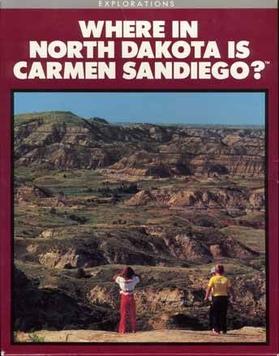
Where in North Dakota Is Carmen Sandiego? is a 1989 edutainment video game. It is the fourth game in the Carmen Sandiego video game series after World (1985), U.S.A. (1986), and Europe (1988). Having observed the popularity of the Carmen Sandiego franchise in the education of school children, educators were inspired to develop a North Dakota version to teach North Dakotans about their state's history and geography.

Donald's Alphabet Chase is a 1988 educational video game developed by Westwood Associates and published by Walt Disney Computer Software. It was released on various home computers including the Amiga, Amstrad CPC, Apple II, Commodore 64, DOS and ZX Spectrum. An Atari ST version was planned by Nathan Software but got no release. The game was released in five different languages including English, Spanish, French, Italian and German.
References
- 1 2 Levy, Steven (2010). "Chapter 19: Applefest". Hackers: Heroes of the Computer Revolution (25th Anniversary ed.). O'Reilly Media. pp. 326–332. ISBN 978-1449388393.
- ↑ McFadden, M. M. (1987). "Antique Softkey for Frogger". Computist . SoftKey Publishing (41): 28–29.
- 1 2 Jones, Bruce W. (1985). "Spiradisk Info". Hardcore Computist . SoftKey Publishing (25): 4.
- ↑ Etarip, Rich (1990). "Softkey for Lunar Leepers". Computist . SoftKey Publishing (83): 10–11.
- ↑ Etarip, Rich (1990). "Softkey for Jawbreaker". Computist . SoftKey Publishing (82): 16.